Make Pad Thai Your Way at home with our easy step by guide complete with vegetables, rice noodles, shrimp, tofu & a traditional sauce. This classic street food from Thailand is the perfect 30 minute meal.
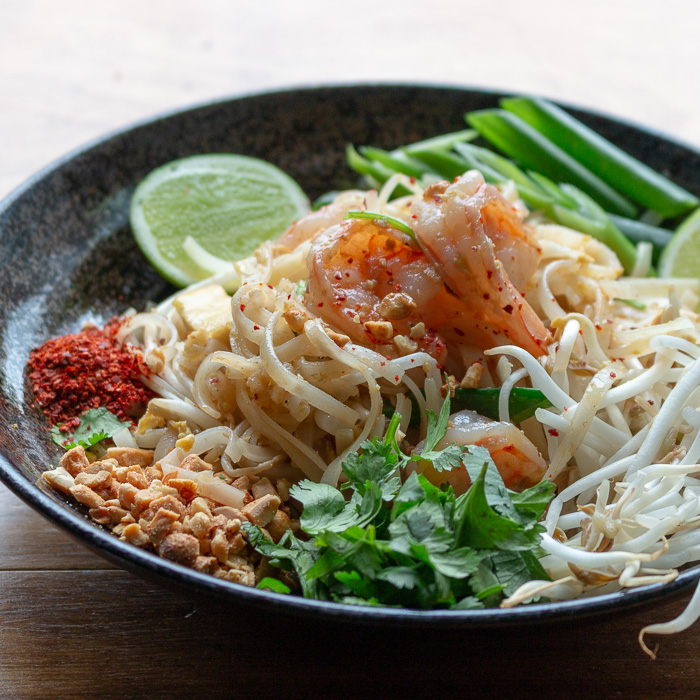
One slurp of your Pad Thai Your Way and you will be teleported to a moment you sat on one of those little plastic stools after visiting your favorite street vendor in downtown Bangkok. You are going to love this recipe because the silky al dente noodles are completely addictive.
Tamarind, palm sugar (or brown sugar) and fish sauce are the three magical ingredients in the sauce. Just like our spicy chicken basil recipe, we love the unique flavor blending of salty, sweet, sour and spicy in one little dynamic bite.
Jump to:
- Pad Thai Your Way – Made just to order…
- More Noodles from Around the World
- Traditional Pad Thai Magic Sauce
- What is Tamarind and What Does it Taste Like?
- Tamarind in Different Forms
- What is a Good Substitute for Tamarind Paste?
- How to Make Pad Thai Magic Sauce
- “Funky” Taste of Pad Thai
- It’s all about the Noodles
- How to Soften Rice Noodles?
- Additions
- Dietary Adaptations for Pad Thai
- Pad Thai YOUR Way
Pad Thai Your Way – Made just to order…
Pad Thai is a dish that is made to order, just the way you like it. Every person has their own standard of how sweet, salty, sour or spicy they like their pad Thai sauce and it can be adjusted to suite your personal preferences. In addition, some people like chicken, some like shrimp or some like tofu.
Maybe some want extra vegetables or less vegetables. It does not stop there. Then you get to pick your garnishes. Some people like fresh limes, garlic chives, crushed peanuts, chilies, or extra raw bean sprouts or maybe nothing extra on top at all. Make it just the way YOU like it!
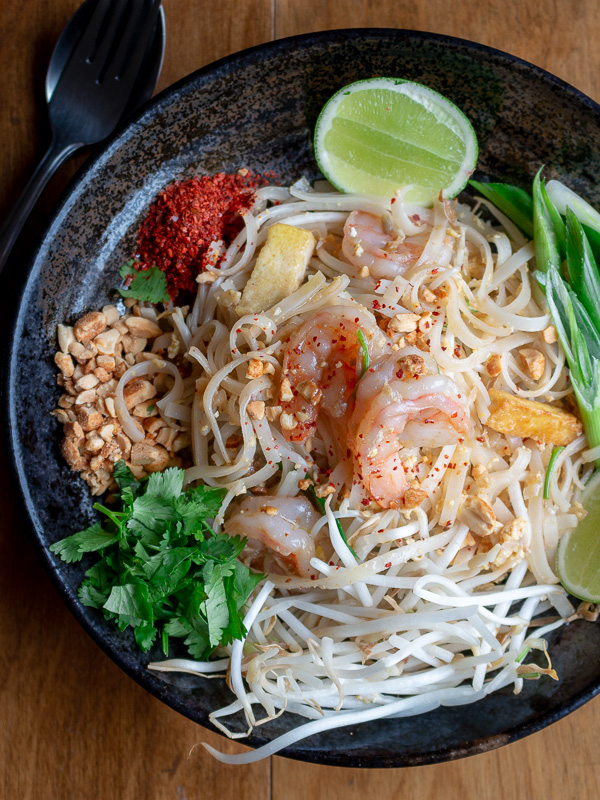
More Noodles from Around the World
Orecchiette and Chicken Sausage in a Garlic Wine Sauce (Italy)
Sopa de Fideo (Mexican Noodle Soup) (Mexico)
Better than Take Out Vegetable Lo Mein (China)
Butternut Squash Vegetarian Lasagna (America)
Golden Spiced Noodle Soup (Asian Fusion)
Cinque de Terre's Ligurian Trofie al Pesto (Italy)
Shrimp Tempura Udon Noodles (Japan)
Camote Bihon (Sweet Potato Noodles) (Philippines)
One Pot Creamy Kale Pesto Pasta (America – vegan, dairy-free)
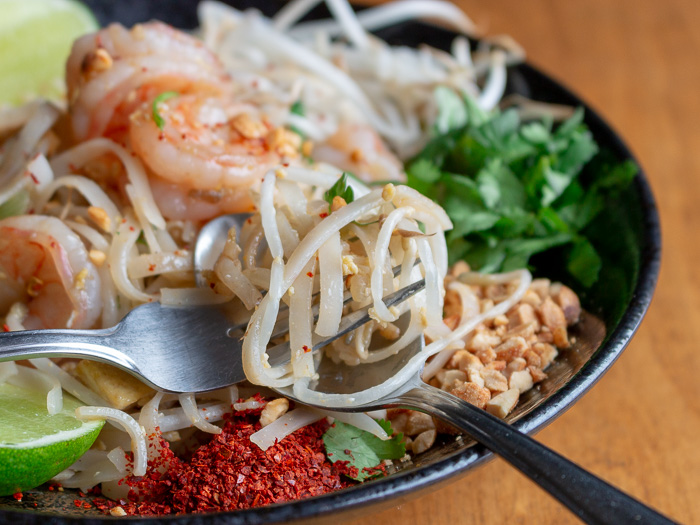
Traditional Pad Thai Magic Sauce
This traditional sauce is magical because it has the perfect balance of sweet from the palm or brown sugar, sour from the tamarind and savory from the fish sauce. Have you ever been to Thailand? Then you probably know that if you are getting served a Pad Thai anywhere else in the world and it has a red tinge, then it is not traditional Pad Thai.
Did you know that many restaurants (not in Thailand) add ketchup to the Pad Thai sauce? Yes, Really and that is what gives it this odd red tinge. Pad Thai should NOT be red as a matter of fact it is a light brown.
Here are the three basic ingredients for a tradition pad Thai sauce...
- tamarind
- fish sauce
- palm sugar
There is no oyster sauce, no ketchup, no sriracha sauce. If you happen to be in Thailand and your Pad Thai is slightly red, that is because they probably added a little fermented bean paste with chili.
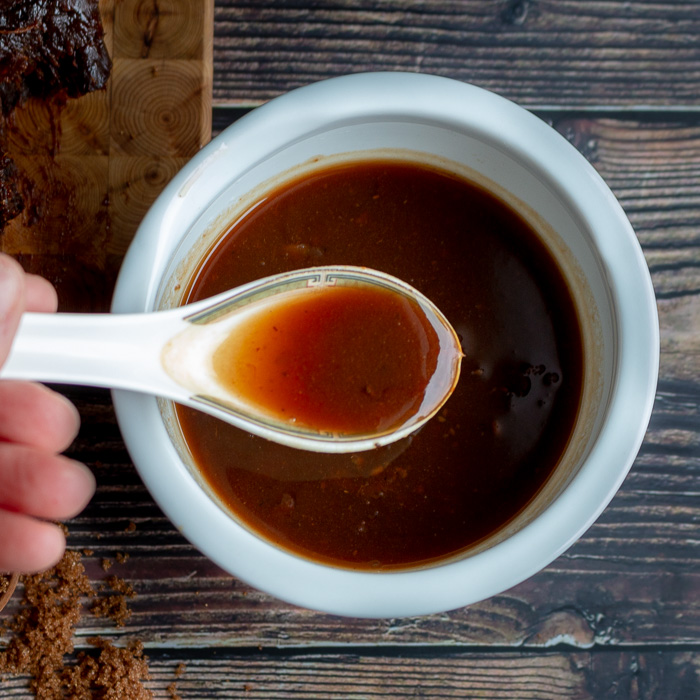
What is Tamarind and What Does it Taste Like?
Tamarind is actually a tree. The tamarind tree produces these legume pod fruits with pulp and seeds inside. This Tamarind pulp is the secret ingredient to a delicious Pad Thai Your Way. Tamarind pulp has an earthy sourness to it.
You know that iron flavor that molasses has without the sweetness, it is kind of like that. It is difficult to describe other than we just love it. We love using tamarind in curries, chutneys and many different Asian recipes. You can even make a tamarind iced tea that is quite refreshing.
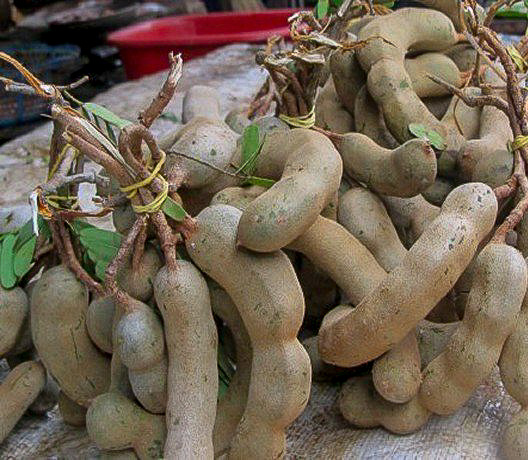
Tamarind in Different Forms
- Whole tamarind pod with seeds and pulps still inside freshly picked from the tree
- Dried tamarind pastes in a block– this is the kind we used. It looks like a brick of date paste and your brain thinks it will be sweet, but it is surprisingly sour.
- Tamarind paste in a jar that is conveniently is thin enough to stir and measure
- Tamarind juice comes in a jar and is in liquid form.
You can use any form of tamarind in this recipe. Dissecting a whole tamarind pod to remove the seeds and scrape away any of the paste is obviously the most challenging of the options from a time perspective. We prefer using a tamarind paste in a block or jar of tamarind paste.
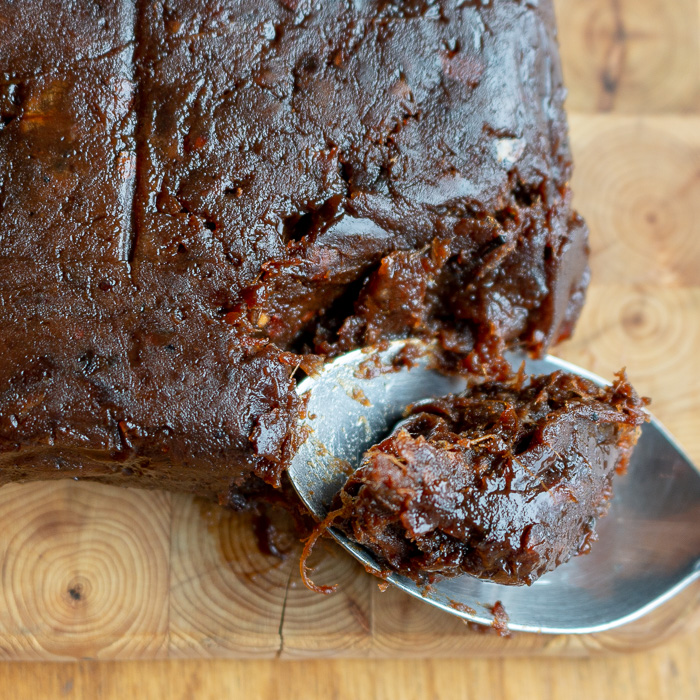
What is a Good Substitute for Tamarind Paste?
We know that sometimes it may be difficult to obtain tamarind paste. Tamarind is mostly sour and has a deep iron taste and slightly sweet. Here are some exchanges and substitutes for tamarind paste...
- Pomegranate Molasses is reduced pomegranate juice and has that sour but slightly sweet undertones and is about the closest substitute for tamarind . It is much thinner than tamarind paste. If you use pomegranate molasses instead of tamarind in your Pad Thai sauce, reduce the amount of hot water added. Use only 1 tablespoon, just enough to melt the brown sugar or palm sugar.
- Pureed Prunes and rice vinegar seems like an odd combination but just trust us. It works. For every 4 dried prunes, add 1 tablespoon of rice vinegar. Place both your prunes and vinegar in a food processor to blend. If you need to, you can add a little water to help blend into a thick paste. You can use pureed prunes and rice vinegar paste in the same ratio as tamarind paste.
How to Make Pad Thai Magic Sauce
- You are going to need to dissolve the palm sugar or brown sugar along with a little hot water along with the tamarind paste. This creates the perfect coat the back of the spoon consistency you are going for the magical Pad Thai Your Way sauce. You can do this with just heating up a little water in a tea kettle or in the microwave.
- Then, add the heated water to the brown sugar and tamarind to dissolve. Stir and add in your fish sauce.
- It's that simple. If you use the tamarind thin juice you may need to actually cook your tamarind and palm sugar/brown sugar on the stove top to give it the thicker texture. Using a tamarind paste, is just easier.
“Funky” Taste of Pad Thai
Funky is a good thing. It is what makes Pad Thai Your Way, traditional and addictive. The Funky taste comes from the fish sauce, sweet pickled daikon radishes and sometimes dried baby shrimp.
It’s that little funky taste that keeps you going back for that next unexpected delicious bite. Your taste buds just can’t quite figure it out, so the only cure is to just keep eating more. There is an explosion of flavor and texture going on in your mouth.
Fish Sauce
Most generally speaking, you can find fish sauce at your local grocery store or Asian markets. It adds a deep savory flavor in pad Thai, Thai style ground beef bowls and even prik nam pla sauce. If you need your fish sauce to be gluten-free, be sure to try Red Boat and Thai Kitchen gluten-free fish sauces.
There is really not a good substitute for fish sauce if you need this recipe to be vegan as then it would be missing that special Funky flavoring. If you are desperate, you can add a soya sauce or a tamari sauce but then just call it stir fried noodles. Fish sauce is not optional.
Sweet Preserved Pickles
Sweet preserved daikon radish pickles are completely optional, but they do give your Pad Thai Your Way that perfect delicious funky flavor throughout the noodles. Please note that these are “sweet” and not the “savory” preserved daikon radish pickles. Sometimes they are also called sweet preserved turnip pickles.
Sweet preserved pickles are a more challenging item to locate and you will need to go to an Asian market or online to find them. We actually make our batch of sweet preserved daikon pickles homemade. If you chop them up finely, you can get that delicious flavor throughout the noodles.
Dried Baby Shrimp
Dried baby shrimp are an optional item for your Pad Thai Your Way. They give a little layer of salty, briny flavor to the recipe if you chop them up finely.
You can find dried shrimp in Asian grocery stores or they can be purchased on line. Personally speaking, we would just skip these if you do not have them. We want not substitute bonito flakes in this recipe because that will give this recipe a different flavor profile. We did not include dried shrimp in our recipe, but it is often included in traditional Pad Thai.
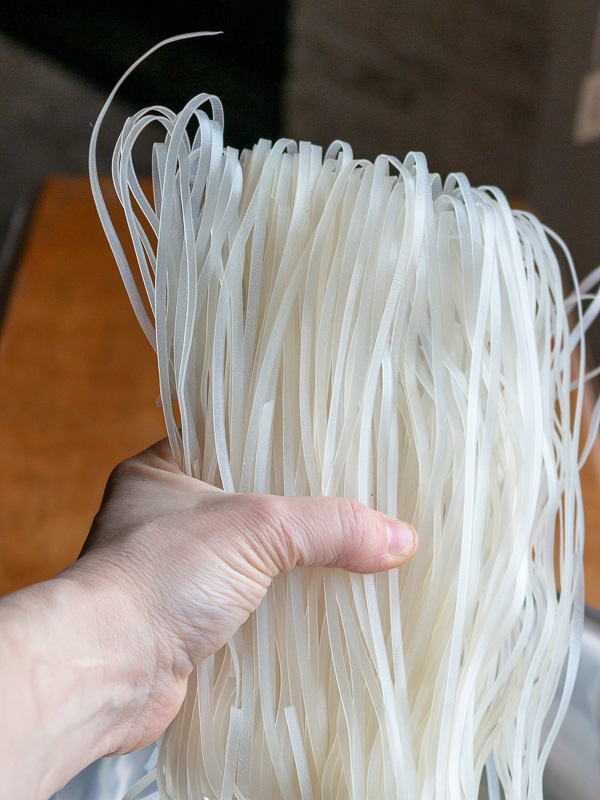
It’s all about the Noodles
Traditional Pad Thai rice noodles are flat and medium width and usually gluten-free. (If you are celiac, be sure to check to make sure your noodles were created in a gluten free environment) The most important part of this recipe is getting your noodles to the right consistency. Pad Thai rice noodles usually come dried.
You will need to soften your noodles slightly before stir frying them. Do not soften them all the way to al dente, because you are going to be cooking them again. No one likes mushy noodles.
Your goal is for a pliable but still firm to the touch noodle. It is actually better for them to be under cooked at this prepping point. You can always add a little water to your wok to finish the cooking process when you add the rest of your ingredients.
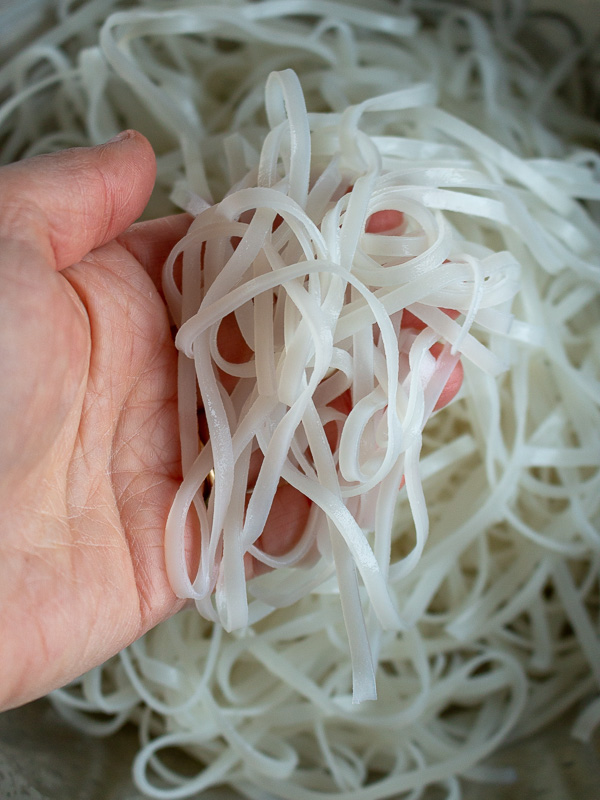
How to Soften Rice Noodles?
Option 1: Place your dried Pad Thai Rice noodles in a large bowl and cover with boiling water for just about 2 minutes or until just start to get pliable but still firm to the touch. Then drain and rinse with cold water.
Caution: It takes just seconds for the noodles to go from just pliable to mush. Keep your eyes and hands on the noodles to keep checking on them. Every brand, thickness and type of Pad Thai rice noodle will vary on the time needed.
Option 2: Place your dried Pad Thai Rice noodles in a bowl and cover with luke warm water for about 30 minutes until the noodles are just pliable but still firm to the touch. Drain and rinse with cool water. DO NOT leave the noodles sitting in the luke warm water as they will continue to soften.
If you are a less attentive cook, we would encourage you to go with option 2. If you are short on time, go with option 1.
Additions
The beauty of this recipe is you can add or not add, anything your little heart desires. Do not panic when you see the long list of ingredients. Many ingredients are optional and some are listed more than once to help you understand the process.
Protein:
We are big shrimp fans. However, you can also use thinly sliced chicken, mushrooms, pork, beef, tofu or any other protein you desire. In order to get that lovely quick sear on your shrimp, we like to cook them first just until no longer translucent.
We also cut up our firm tofu into thin match sticks and pan sear on all sides in a pan and have them ready to be added to the dish at the end. It is really important that you get your tofu dried well with paper towels before pan frying.
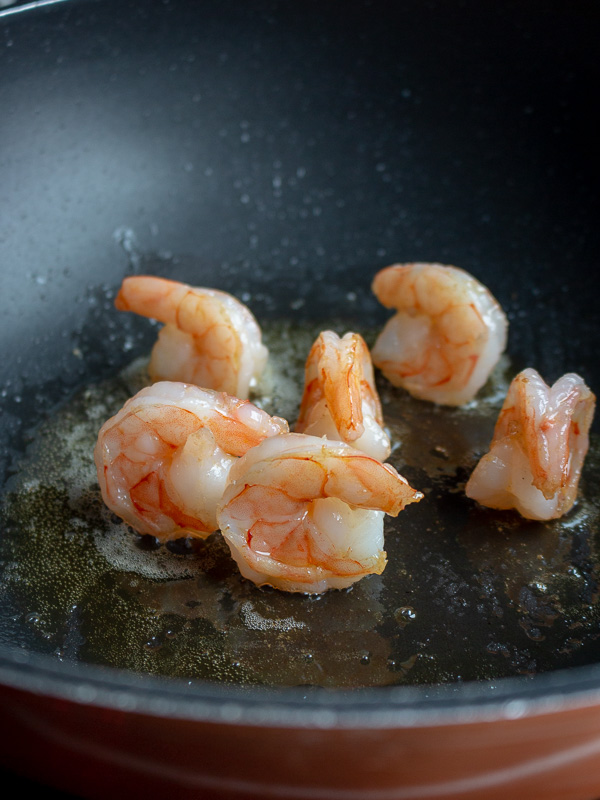
Aromatics:
Fried Shallots and fresh garlic are key to a good Pad Thai. If you do not have shallots, exchange with an onion. An optional aromatic that we discussed above is the sweet preserved daikon radish pickles.
Toppings and Garnishes
Traditionally, Pad Thai will have fresh bean sprouts (sprouted mung beans) and garlic chives tossed in the fried Pad Thai and extra for garnish. We were not able to get fresh garlic chives, so we exchanged with spring onions.
A must have garnish that really brings this whole dish alive is fresh squeezed lime juice. A little crushed peanut, chili either fresh or ground and a little fresh cilantro to serve are always a nice touch. Check out our Step by Step Instructions below...
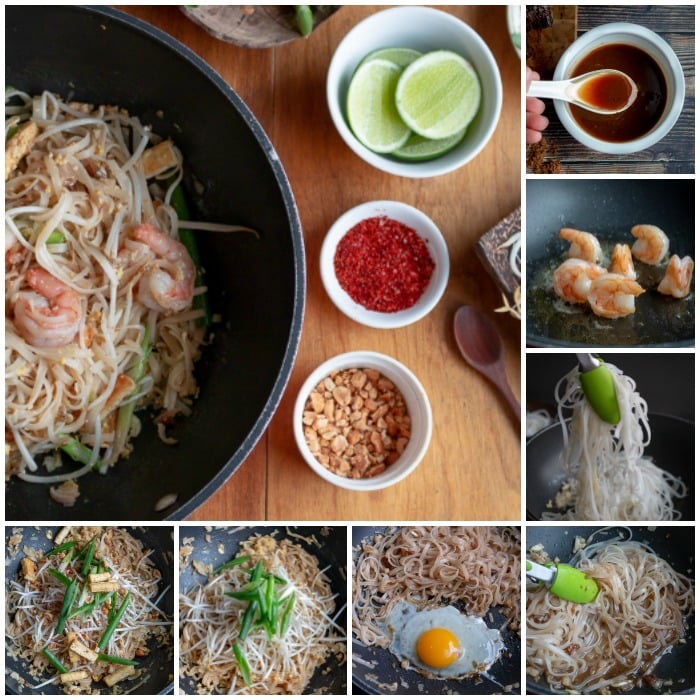
In Thailand, it is sometimes common to serve a little extra palm sugar/brown sugar on the side. This way you can make the Pad Thai YOUR Way and add extra sour, sweet or spice to your taste. Don’ forget about the egg. A fried egg is an optional item but we love the little extra protein and texture it adds to the dish.
Dietary Adaptations for Pad Thai
If you are looking for ways to lower the carbohydrate count, exchange the brown sugar with a sugar alternative and try exchanging zucchini zoodles for the Pad Thai noodles, or exchange most of the noodles with mung beans.
If you are watching your sodium intake, reduce the amount of fish sauce and increase the aromatics. We used gluten-free fish sauce and gluten-free noodles for this recipe.
Be sure to try our Thai Firecracker Shrimp Party Appetizers with our Prik Nam Pla dipping sauce or our Thai Hot and Sour Prawn Soup for a starter. How about a No-Churn Dairy Free Mango Swirl Ice Cream for dessert? Check out our Thai Recipe Category for more delicious recipes.
Did You Like Our Recipe? Leave a ⭐⭐⭐⭐⭐ rating and/or a review in the comments section below. Your feedback is always appreciated! Follow us for more delicious recipes on Pinterest, Instagram, Twitter and Facebook! Don't forget to sign up for our email list for more free recipes.
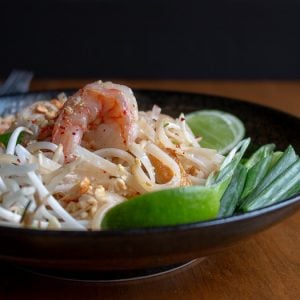
Pad Thai YOUR Way
Ingredients
- 12 oz Pad Thai Rice Noodles medium size
- Water for softening noodles
Sauce
- 6 tablespoon Brown sugar (can use palm sugar or light or dark brown sugar or sugar alternative)
- ½ cup Tamarind
paste or puree (check out our notes below for substitution ideas) - 4 tablespoon Fish sauce
- 6 tablespoon Hot water
Stir Frying
- 4 tablespoon Oil for frying
- 6 oz Tofu
(dried well and cut into matchsticks) – optional - 8 oz Shrimp
raw large peeled, deveined (or about 3-4 shrimp per person) - 1 Shallots 1 peeled and sliced into half-moons (or about ½ cup)
- 4 cloves Garlic
peeled and minced - ¼ cup Sweet preserved daikon radish pickles
optional - 4 Egg
optional - 2.5 cups Bean sprouts (mung Beans) (reserve some for garnishing)
- 6 Green onion cut into match stick sizes (reserve some for garnishing)
- ½ cup Peanuts chopped (reserve some for garnishing)- optional
Garnishes
- 4 wedges Limes
fresh - Chili
ground dried or fresh- optional - Beans sprouts
(sprouted mung beans) optional - Green onions
optional - Ground peanuts optional
Instructions
- Prepare your noodles: Place your noodles in a large bowl and cover with luke warm water for about 30 minutes or until the noodles are pliable but firm to the touch. Drain and rinse with cold water. Drain and set aside. (Alternatively, you can boil water and pour over noodles for about 2-5 minutes or just until pliable but still firm to the touch, drain, rinse with cold water and drain. Keep a very close eye and feel on noodles so they do not get too soft) Set aside. Do not over soakyour noodles until they are aldente. The noodles will be stir fried again so they need to be firmer than aldente.
- Prepare your sauce: In a medium bowl, add brown sugar, tamarind paste, fish sauce and hot water. Stir to dissolve brown sugar and tamarind paste. The paste should be a little thick so that it coats the back of a spoon. Remove from pan and set aside.
- Place oil in pan and fry your tofu until crispy on all sides. Remove from pan and set aside. Add your shrimp and pan sear on all sides until pink and no longer translucent. Remove from pan and set aside.
- Prepare all of your prepared ingredients in place (mise en place) so you are ready to do a quick stir fry. (extra oil for frying, shallots, garlic, Sweet preserved daikon radish pickles, Pad Thai softened noodles, eggs, bean sprouts, green onions and peanuts, fried tofu, cooked shrimp and Pad Thai prepared sauce) and set it next to your stove. Set aside and separate some bean sprouts, green onion and peanuts for garnish for 4 servings.
- If you have a super large wok and everyone wants the same ingredients, you can make it all in one batch. However, you can make your Pad Thai YOUR way with different additions for each person. Then you can make each portion separately. This recipe makes about 4 portions.
- Stir frying: We prefer to make each person’s serving separately as we have a smaller wok. Add a little oil in your wok and add the about ¼th of the shallots, ¼ th of the garlic , ¼th of the sweet preserved daikon radish pickles and stir fry until aromatic. Next add ¼ of the prepared Pad Thai rice noodles and ¼ th the Pad Thai sauce and stir fry until the noodles are well coated and almost aldente. (if your wok is dry and the noodles are still not aldente, you can add a tablespoon or two of water to your wok and fry until aldente.)
- Move your noodles to one side and up on the edge of your wok. Add an egg and break the yolk and cook until scrambled and then mix your noodles into eggs. Add ¼ th of the bean sprouts, ¼ of the green onions, fried tofu, shrimp and just a few ground peanuts and stir fry for a minute to incorporate all the ingredients. Repeat this process for the other 3 servings.
- Serve your Pad Thai YOUR way with lime wedges, extra ground peanuts, mung bean (bean sprouts), dried chili or fresh chili. Spritz with lime juice and enjoy.
Video
Notes
Nutrition



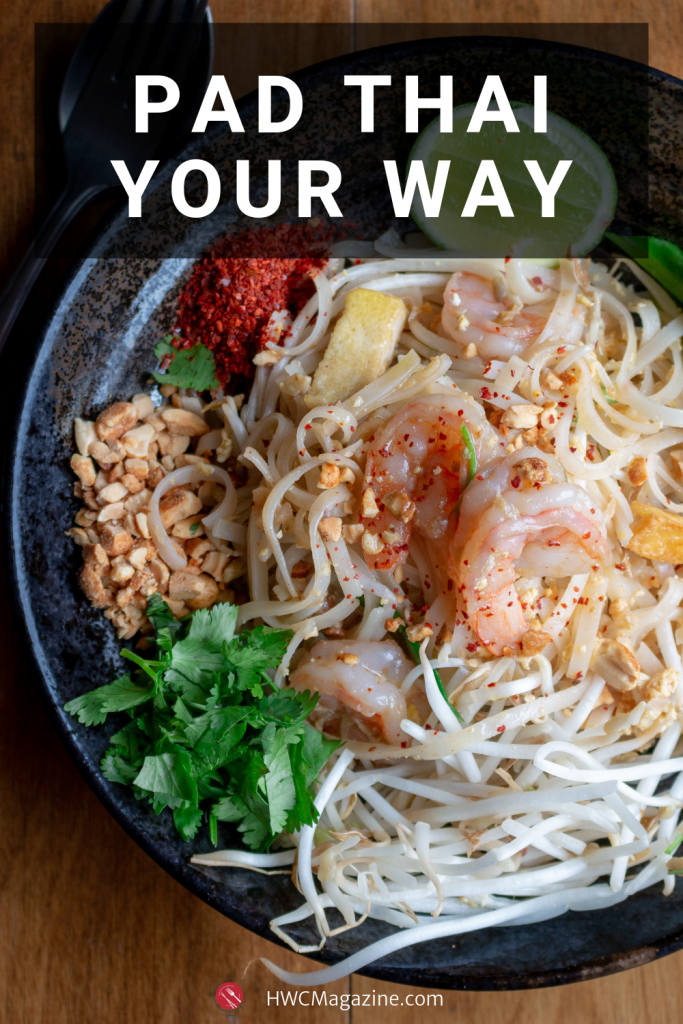
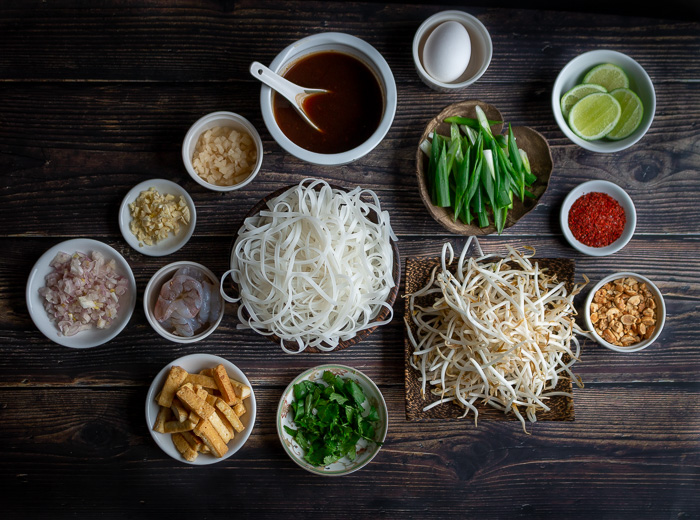
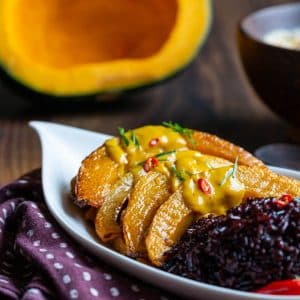
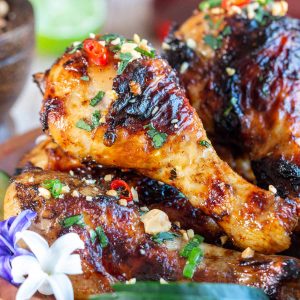
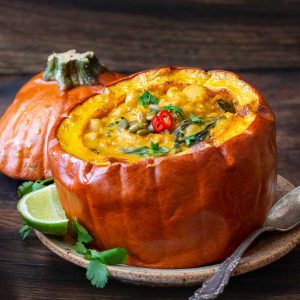
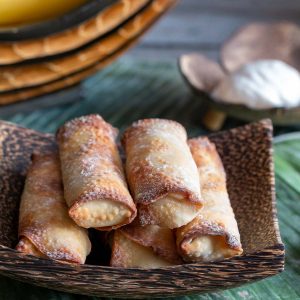

Healthy World Cuisine says
Thanks Greg. I think the main reason it can be so good in some places and bad in others is that they did not make it YOUR way but THEIR way. Each person has their own taste preference and it really needs to be made to order and that is why it would be great for us all to try at home.
Rufus' Food and Spirits Guide says
I love this dish, but it's so amazing how it can be so good at some places and so bad at others. So glad to have your recipe. I KNOW it will be good.
Korena in the Kitchen says
What a fantastic tutorial! Great tip about soaking the noodles in cold water. I've always been a bit scared to try pad thai at home, but this bolsters my confidence. I love Thai food as well and this reminds me that it's been waaaay too long since I had any!
Healthy World Cuisine says
Thank you Korena. I think one additional important tip is to under soak your noodles as they continue to cook in the wok. Also rinse your noodles after the soak. I think it is better to start with noodles that are too firm than closer to aldente. Take care, BAM
Charles says
Hi Bam, I never tried to make this myself before, but I really want to because it's so tasty. I find it's only really possible to get the correct noodles from asian stores and nothing is labelled in any kind of language I understand so I find even the basic ingredient really hard to find. Same for dishes like pho... I want to make them but can never seem to find the noodles!
Healthy World Cuisine says
Hello Charles, I found this website that has ingredients for order. I have never used them but maybe an option for you. http://importfood.com/recipes/tstirfryNoodle.html
Take care, BAM
cravesadventure says
Love this type of receipe because you can mix it up and use different veggies depending on the season! Have a Great Weekend!
Healthy World Cuisine says
You sure can or feel to substitute with the veggies that are seasonal where you live. I just like having a little crunch with the noodles and this comes from the mung beans and crushed peanuts.
Courtney says
I love pad thai - but am just so intimidated by it. It's one of those recipes I feel I'd completely mess up. Some day, though, I will conquer it. Just gotta build a little more confidence. 🙂
Healthy World Cuisine says
You can do it Courtney. In order to give yourself some confidence, make sure you have every chopped and ready to go and all with in reach and next to the wok. Then I am sure it will be a success. Take care, BM
susartandfood says
Everything is just too pretty - please set an extra plate I'm booking a flight
Healthy World Cuisine says
Any time just let me know when your plane is due for arrival. Take Care, BAM
Jeno @ Week Nite Meals says
Hi Bam! I've not cooked pad thai for a long while, thank you for the recipe! It's great you included how to use the dried tamarind, I've seem them in the Asian market, but never knew how to use them properly, plus they are not a part of Chinese cuisine, so it's very interesting to learn!
Healthy World Cuisine says
Dried tamarind does not look too pretty while it is melting in the hot water. It kind of looks like chocolate melting with the membranes of the tamarind. However, it really does add a special flavoring to the sauce. If you cannot find you can substitute with molasses and lime combo. Close but not the same. Take care, BAM
Andrea says
I love Thai food. I used to live above a Thai Restaurant and I ate their almost every night. I really miss that place. I will definitely have to try this recipe.
Healthy World Cuisine says
Oh Andrea that is so dangerous...living above a thai restaurant. I would have eaten there breakfast lunch and dinner if given the chance. What country was that in? Take Care, BAM
Andrea says
In the U.S. near Chicago. I was in there so much, the owner knew me by name and what my favorite dishes were. Pad Thai was one of them.
Hannah (BitterSweet) says
Mmm, who doesn't love pad thai? I've actually never used tamarind paste in mine though, so I'd be very curious to give your version a try. Naturally, my renditions are completely inauthentic and more like a noodle stir-fry as a result. Tamarind is just a bit harder for me to find, but hopefully worth the hunt.
Healthy World Cuisine says
Hello Hannah, If you have a really hard time finding either dried tamarind or tamarind paste you can substitute the following... molasses plus lime juice, or brown sugar plus lime juice. However, tamarind is really a unique flavoring and not easy to get same flavoring by substitution but it is close.
zestybeandog says
This looks like my kind of meal! Well all your meals look like my kinda meal... 🙂 I love tamarind!
Healthy World Cuisine says
Thanks Jen. You are so very sweet. Have a super weekend. Take care, BAM
gardenfreshtomatoes says
I have a little jar of tamarind paste that I've never even opened...you've given it a purpose!
Healthy World Cuisine says
Actually this is a super fast dish to make the longest time is just the cutting and soaking prep but the actual cooking time is less than 5 minutes. Give it a try and let me know how it goes. Take care, BAM
samology says
oh my gosh...!!! You're really an all-rounded chef! You weren't kidding about being international with your food!! I am in love with Pad Thai and I'm ashamed to say that I haven't even attempted it yet! haha.. Should definitely give it a try though.. yummayyy!! Ingredients don't seem to hard to find too!
Healthy World Cuisine says
Thanks Sam, I have also seen your dishes and you are also quite a well rounded chef and baker. You should see my spice selection- really big as I love to cook all cuisines.
Choc Chip Uru says
Glad your enjoying the wonderful flavours of Thai food - it is definitely one of the most exotic delicious cuisines which I do believe you are capturing perfectly 🙂
Cheers
Choc Chip Uru
Healthy World Cuisine says
Thanks CCU! I am so on a Thai cuisine kick this week. Guess what I am eating for dinner? Thai Green Fish Curry. So spicy, so good. Take Care, BAM
ChgoJohn says
Pad Thai is such a tasty dish and I'm sure yours is delicious. I rate Thai restaurants by their Pad Thai, ordering it on my first visit. If it's good, I'll be back and try other menu items. If I find the Pad Thai to be lacking, I never return. This dish is of such cultural importance to the Thai people that a restaurant must be able to prepare it well or I'll go to one that does. You've inspired me, BAM, to give this a try. Being able to make Pad Thai whenever I want would be fantastic!
Healthy World Cuisine says
I have only eaten Pad Thai while visiting in Thailand. Sometimes we make it at home. I have never tried it in any other country. There are a couple of Thai Restaurants in HK. I should go check them out and try out your great philosophy. I also want to better my skills so always open to ideas.